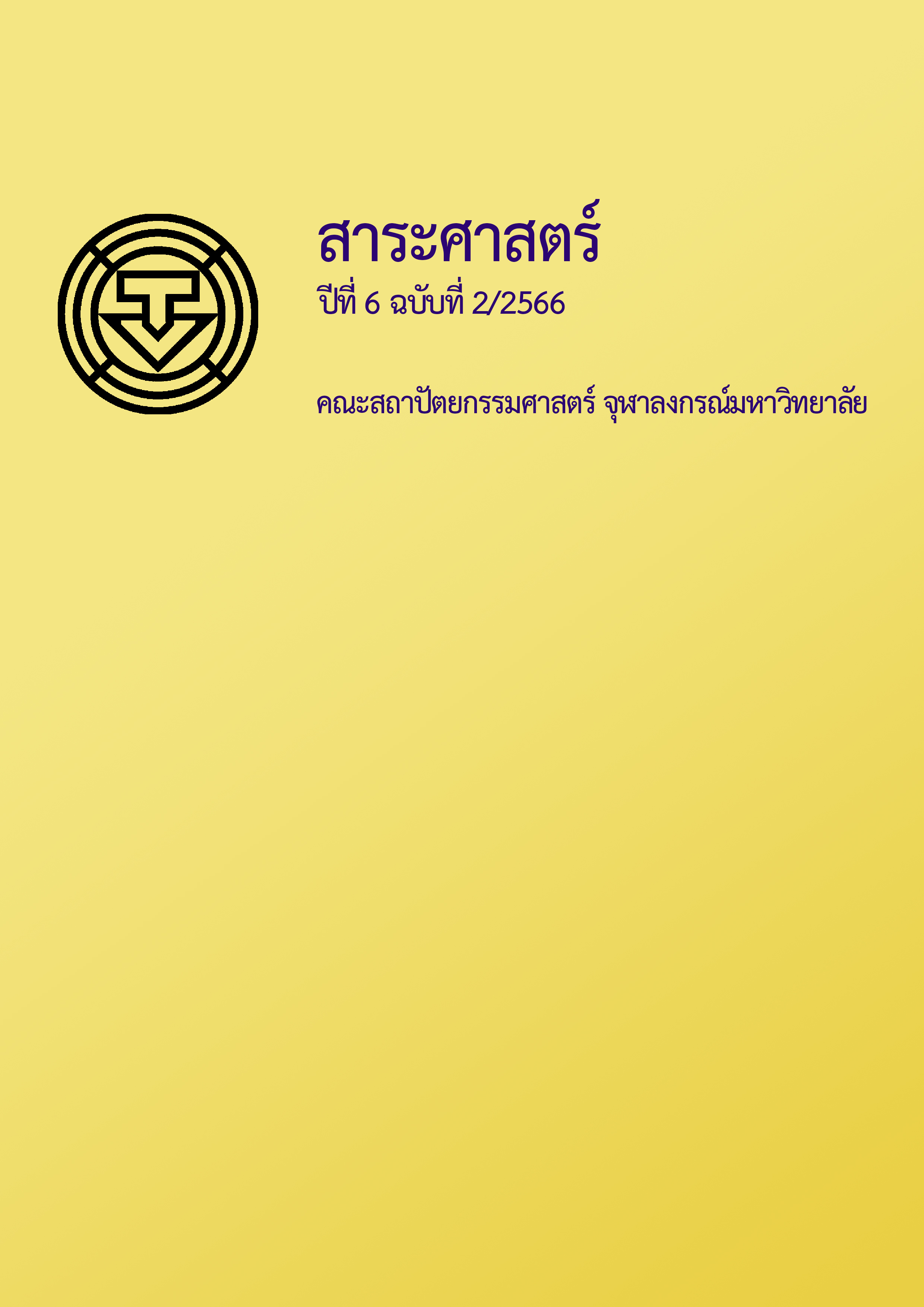The Method of Social Network Analysis for Studying Tourist Destination Networks
Main Article Content
Abstract
This article examines the methods used in analyzing tourist destination network through the concept of social network analysis using a literature review method. The purpose of this study is to investigate the methods and network analysis models used in tourism planning, as well as to explore the direction of current research on tourism networks. The findings suggest that the analysis of tourist destination networks is still a relatively under-researched area in network studies related to tourism. The analysis of tourist destination networks employs the method of measuring centrality value as a means of studying the role through computer software. In this study, nodes in the network represent tourist destinations, and edges represent the travel routes between them. Moreover, most research studies conducted abroad also emphasize the study of the diversity of situations and the differences in data to enhance a better understanding of network patterns. In contrast, Thailand's research is limited by data collection constraints. To conduct network analysis in Thailand, the data must be a large and clear travel point-to-point pattern, such as a Call Detail Record (CDR), which displays apparent tourist behavior and network patterns. The expected benefit from this study extends the tourist destination network to spatial planning for efficient tourism policy-making.
Article Details
References
กระทรวงการท่องเที่ยวและกีฬา. (2563). สถิตินักท่องเที่ยวภายในประเทศ ปี 2562 (จำแนกตามภูมิภาคและจังหวัด) (Domestic Tourism Statistics Q1-Q4 (Classify by region and province)). https://www.mots.go.th/more_news_new.php?cid=618
กฤษฎาภฤศ ปึงภัทรกิจ. (2561). การศึกษาและวิเคราะห์เครือข่ายการท่องเที่ยวภายในประเทศ [วิทยานิพนธ์ปริญญามหาบัณฑิต, จุฬาลงกรณ์มหาวิทยาลัย]. CUIR. http://cuir.car.chula.ac.th/bitstream/123456789/74276/1/En_6070905121_Krissadapruk%20Pu.pdf
คณะกรรมการนโยบายการท่องเที่ยวแห่งชาติ. (2564). แผนพัฒนาการท่องเที่ยวแห่งชาติ (พ.ศ. 2564 - 2565). สำนักงานปลัดกระทรวงการท่องเที่ยวและกีฬา.
ชัยศิลป์ อุตส่าห์ และบรรเจิด สิงคะเนติ. (2561). กฎหมายในการบริหารและพัฒนาการท่องเที่ยว : ศึกษากรณีการกําหนดเขตพัฒนาการท่องเที่ยว. วารสารวิชาการคณะมนุษยศาสตร์และสังคมศาสตร์ มหาวิทยาลัยราชภัฏนครสวรรค์, 6(1), 175-206. https://so05.tci-thaijo.org/index.php/hssnsru/article/view/213075
ฑิตฐิตา บุญเจียม และอรอนงค์ พัวรัตนอรุณกร. (2564, พฤษภาคม-สิงหาคม). การวิเคราะห์พฤติกรรมนักท่องเที่ยวเชิงกีฬา : การศึกษาเชิงประจักษ์ในจังหวัดบุรีรัมย์. วารสารบริหารธุรกิจและการบัญชี มหาวิทยาลัยขอนแก่น, 5(2). https://so04.tci-thaijo.org/index.php/kkbsjournal/article/view/245385
พรคิด อั้นขาว. (2559). การวิเคราะห์เครือข่ายการท่องเที่ยวของกลุ่มจังหวัดภาคกลางในประเทศไทย. มหาวิทยาลัยเทคโนโลยีราชมงคลพระนคร. https://dric.nrct.go.th/Search/SearchDetail/307135
พิชญา ชัยพิมลผลิน และอุบลวรรณา เกษตรเอี่ยม. (2560). การวิเคราะห์เครือข่ายทางสังคมกับการพัฒนาด้านงานวิจัย คณะวิทยาการจัดการมหาวิทยาลัยราชภัฏเชียงใหม่. ใน การประชุมวิชาการระดับชาติ ครั้งที่ 6 วิทยาการจัดการวิชาการ 2017 : การวิจัยยุคประเทศไทย 4.0 (หน้า115-126). เชียงราย: มหาวิทยาลัยราชภัฏเชียงราย.
ภัทราวดี มากมี. (2563). การวิเคราะห์เครือข่ายทางสังคมสําหรับออกแบบการวิจัยทางสังคมศาสตร์. Journal of Educational Measurement Mahasarakham University, 27(1), 32-45.
มานา ปัจฉิมนันท์. (2560). การวิเคราะห์เครือข่ายทางสังคมกับการวิจัยด้านการสื่อสารในองค์การ. วารสารสถาบันพระปกเกล้า, 15(3), 5-18. https://so06.tci-thaijo.org/index.php/kpi_journal/article/view/244112
มิ่งสรรพ์ ขาวสะอาด, ดนัยธัญ พงษ์พัชราธรเทพ, อัครพงศ์ อั้นทอง, ณัฐพล อนันต์ธนสาร, อรุณี อินทรไพโรจน์, วรัญญา บุตรบุรี, และบิณฑิรา วลีธนาพันธ์. (2565, มิถุนายน). การวิจัยและพัฒนาเพื่อเพิ่มขีดความสามารถของการท่องเที่ยวไทยหลังโควิด-19. มูลนิธิสถาบันศึกษานโยบายสาธารณะ.
สฤษดิ์ ติยะวงศ์สุวรรณ. (2555). กรอบแนวคิด วิธีการและเครื่องมือในการวิเคราะห์โครงข่ายทางสังคมของผู้มีส่วนร่วมสําคัญในกระบวนการวางแผนฟื้นฟูเมือง. ใน Built Environment Research Associates Conference 3, 2012 (หน้า 207-220). https://www.berac.tds.tu.ac.th/proceedings
Alamsyah, A., Rahardjo, B. & Kuspriyanto. (2014). Community detection methods in social network analysis. Advanced Science Letters, 20(1), 250-253.
Apostolato, I. (2013). An overview of software applications for social network analysis. International Review of Social Research, 3(3), 71-77. https://doi.org/10.1515/IRSR-2013-0023
Asero, V., Gozzo, S., & Tomaselli, V. (2016). Building tourism networks through tourist mobility. Journal of Travel Research, 55(6), 751-763. https://doi.org/10.1177/0047287515569777
Casanueva, C., Gallego, A., & García-Sánchez, M. (2016). Social network analysis in tourism. Current Issues in Tourism, 19(12), 1190-1209. https://doi.org/10.1080/13683500.2014.990422
Farahani, F., Karwowski, W., & Nichole, L. (2019, June 6). Application of graph theory for identifying connectivity patterns in human brain networks: A systematic review. Frontiers in Neuroscience, 13. https://doi.org/10.3389/fnins.2019.00585
Hwang, Y., Gretzel, U., & Fesenmaier, D. (2006). Multicity trip patterns: Tourists to the United States. Annals of Tourism Research, 33(4), 1057-1078. https://doi.org/10.1016/J.ANNALS.2006.04.004
Jin, C., Cheng, J., & Xu, J. (2018). Using user-generated content to explore the temporal heterogeneity in tourist mobility. Journal of Travel Research, 57(6), 779-791. https://doi.org/10.1177/0047287517714906
Kádár, B., & Gede, M. (2021). Tourism flows in large-scale destination systems. Annals of Tourism Research, 87,103113. Doi: 10.1016/J.ANNALS.2020.103113
Kang, S., Lee, G., Kim, J., & Park, D. (2018, September). Identifying the spatial structure of the tourist attraction system in South Korea using GIS and network analysis: An application of anchor-point theory. Journal of Destination Marketing and Management, 9, 358-370. https://doi.org/10.1016/J.JDMM.2018.04.001
Lacobucci, D. (1994). Graphs and matrices. In Social network analysis: Methods and applications; Structural analysis in the social sciences (pp. 92-166). Cambridge University Press. https://doi.org/10.1017/CBO9780511815478.005
Lee, S., Choi, J., Yoo, S., & Oh, Y. (2013). Evaluating spatial centrality for integrated tourism management in rural areas using GIS and network analysis. Tourism Management, 34, 14-24. https://doi.org/10.1016/J.TOURMAN.2012.03.005
Leung, X., Wu, B., Xie, F., Xie, Z., & Bai, B. (2012). Overseas tourist movement patterns in Beijing: The impact of the Olympic games. University of Massachusetts Amherst.
Marin, A. & Wellman, B. (2011). Social network analysis: An introduction. In J., Scott, & P. J., Carrington, (Eds.), The Sage handbook of social network analysis (pp. 11-25). Sage.
Qin, S., Zuo, Y., Wang, Y., Sun, X., & Dong, H. (2017). Travel trajectories analysis based on call detail record data. In 29th Chinese Control and Decision Conference (CCDC) (pp. 7051-7056). Chongqing, China. https://doi.org/10.1109/CCDC.2017.7978454
Ruhnau, B. (2000). Eigenvector-centrality: A node-centrality? Social Networks, 22, 357-365.
Seok, H., George, A., Barnett., & Yoonjae, Nam. (2021). A social network analysis of international tourism flow. Quality & Quantity, 55(2), 419-439. https://doi.org/10.1007/S11135-020-01011-8
Shih, H. (2006). Network characteristics of drive tourism destinations: An application of network analysis in tourism. Tourism Management, 27(5), 1029-1039. https://doi.org/10.1016/J.TOURMAN.2005.08.002
Sugimoto, K., Ota, K., & Suzuki, S. (2019). Visitor mobility and spatial structure in a local urban tourism destination: GPS tracking and network analysis. Sustainability, 11(3), 919. DOI: 10.3390/SU11030919
Wang, C. & Chen S. (2014). Bibliometric and social network analysis for data mining: The intellectual structure of tourism destination literature. Journal of Testing and Evaluation, 42(1), 229-241. DOI: 10.1520/JTE20120285
Wasserman, S., & Faust, K. (1994). Blockmodels. In Social network analysis: Methods and applications; Structural analysis in the social sciences (pp. 394-424). Cambridge University Press. https://doi.org/10.1017/CBO9780511815478.011
Wasserman, S., & Faust, K. (1994). Centrality and prestige. In Social network analysis: Methods and applications; Structural analysis in the social sciences, (pp. 169-219). Cambridge University Press. https://doi.org/10.1017/CBO9780511815478.006
World Tourism Organization [UNWTO]. (2019). International tourism highlights, 2019 edition. UNWTO. DOI: https://doi.org/10.18111/9789284421152
Zhong, G., Yin, T., Zhang, J., He, S., & Ran, B. (2018). Characteristics analysis for travel behavior of transportation hub passengers using mobile phone data. Transportation, 46(5), 1713-1736. https://doi.org/10.1007/s11116-018-9876-5


